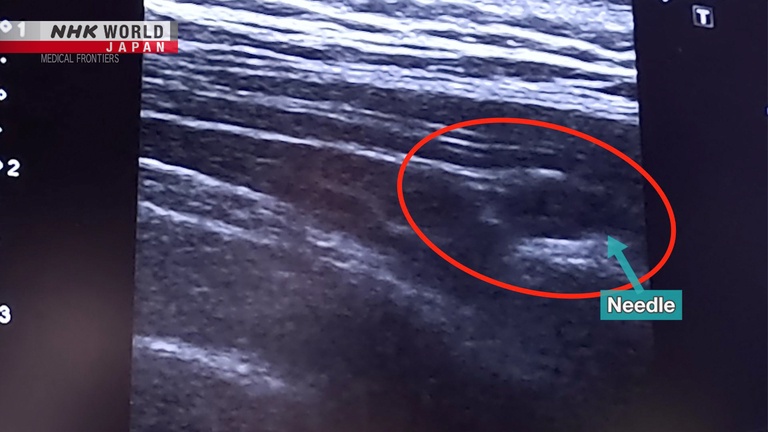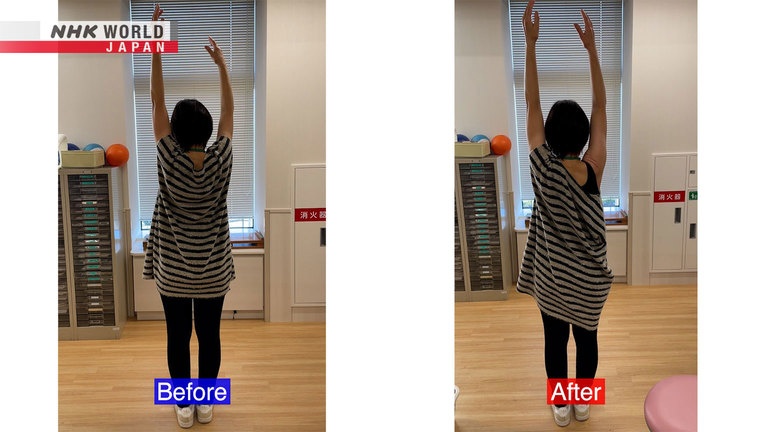Fascia: Cause of Chronic Pain
Fascia is a membrane-like tissue beneath the skin enveloping internal organs. We introduce the latest treatment for shoulder stiffness and lower-back pain utilizing the characteristics of fascia.




Transcript
Join us as we explore Medical Frontiers.
Are you perhaps experiencing chronic pain or tension in your neck, shoulders or lower back?
Even after seeking medical attention, the cause can sometimes remain unclear and the discomfort can persist.
Fascia has been gaining significant attention as a potential cause behind such unexplained pain.
This image shows a type of tissue called "fascia" in a human body, observed during surgery.
It resembles the mesh of a net and protects muscles and internal organs.
Fascia extends widely beneath the skin, covering the entire body like a full-body suit.
The latest research indicates there are six main fasciae in the human body.
The fascia that covers the front of the body runs from the back of the head, along the sides of the neck,
down through the chest, abdomen, and legs, all the way to the tips of the toes.
The fascia covering the back of the body extends from the top of the head down along the back muscles,
through the back of the legs, all the way to the soles of the feet.
Scientists believe that these fasciae work together to control the body's posture and movements.
In 2018, fascia was officially recognized as a bodily tissue
in the World Health Organization's International Classification of Diseases.
In recent years, it has become clear that abnormalities in fascia can cause pain or restrict movement.
In Japan, the study of fascia is still a relatively new field.
One of the researchers exploring its anatomical and physiological aspects is Imagita Hidetaka.
In the past, fascia was considered
unimportant, unnecessary tissue.
But now, we're starting to learn
that it serves crucial functions.
Fascia is gradually drawing attention
as a key tissue.
Let's look at fascia in the cross section of a piece of pork.
The fascia spreads between muscle and fat tissues, forming multiple layers.
It spreads out like a spiderweb.
Fascia is composed mainly of collagen fibers, which make it flexible and strong.
As muscles contract and expand, the fascia between them glides in sync, enabling smooth movements.
Muscles and tendons only move nearby joints,
but fasciae have broader connections.
They can send signals to
distant muscles and tissues,
facilitating smooth movements
throughout the entire body.
Water is necessary for fascia to perform this function.
Imagita conducted an experiment to study the relationship between fascia and water.
As he injected water into fascia taken from a rat, it absorbed the water and swelled up.
What's this? The water and fascia are merging.
When fascia retains water, it becomes more flexible and elastic.
Well-hydrated fascia can move seamlessly together with muscles.
But a lack of water causes the fascia's layers to stiffen, leading to muscle tension and rigidity.
This feature of fascia is gaining attention as a way to treat stiff shoulders.
Raise your arms, and tell me if it hurts.
It hurts now.
This man in his 50s has difficulty raising his arms due to pain.
He works mostly at a desk and suffers from chronic shoulder stiffness.
I get tired easily, but have trouble falling asleep.
I have to do a lot of typing,
but it's difficult and painful.
Orthopedic surgeon Takahira Naonobu is researching the relationship between fascia and shoulder stiffness.
First, he examines the inside of the shoulder using ultrasound.
This white line is hardened layers of fascia.
The dark areas are muscles, and the white part in between them is fascia.
When layers of fascia stick together, muscle movement is restricted,
and it becomes difficult to move the shoulders.
I'll insert a needle there and spread it out.
The syringe Takahira is holding contains saline solution.
He injects it into the fascia.
The layers are starting to separate.
This is a close-up at the moment of injection.
The layers of fascia that were stuck together immediately begin to detach,
allowing for smoother muscle movement.
This treatment is known as hydrorelease.
It results in an instant change in the condition of the patient's shoulders.
Try raising your arms again, as high as possible.
- Wow.
- Your arms now touch your ears.
- I feel lighter.
- More comfortable?
When comparing how high the arms can be raised before and after hydrorelease,
there's a notable increase in range of motion.
We asked Takahira about various treatments that target fascia.
Prof. Takahira, thank you so much for your time today.
It's such a hot topic, fascia, so thank you so much.
Thank you.
So what are the main functions of fascia?
Fasciae envelop the whole body,
enabling smoother movements.
Additionally, because they are located
under the skin, they offer cushioning.
Therefore, they can help prevent
sports-related injuries, for example.
What are some of the advantages and I guess the disadvantages of hydro release?
The advantage is it works quickly
to remove pain and improve mobility.
The disadvantage is that
only doctors can administer it.
It involves needle insertion,
so you need to visit a clinic.
The duration of the effects of hydrorelease varies from person to person.
Over time, some people may experience stiff shoulders again.
And I think a lot of people suffer from chronic pain unknown causes.
In this case, should we suspect that it's from the fascia?
In my practice, I commonly see patients
with shoulder stiffness and lower-back pain.
For about 85% of cases of
lower-back pain, the cause is unclear.
Similarly, with shoulder stiffness, the cause may
remain unknown, even after X-rays or other tests.
In cases where treatment doesn't lead to
improvement, fascia might be involved.
Abnormalities in fascia limit body movement.
This can lead to mild pain that goes unnoticed.
But if it lasts for years, it can affect
ligaments or intervertebral discs.
That can lead to herniated discs,
nerve pressure and numbness.
Suspecting fascia involvement is crucial.
But accurate diagnoses remain challenging.
Recent research suggests that fascia plays a role in injury treatment.
Enari Kumiko has been figure staking for more than 20 years.
I've been participating in masters' competitions.
Sometimes I won, other times I came in
second or third place, and so on.
Lately, I've been doing well and ranking high.
However, she suffered a serious injury during a competition in 2022.
During my performance, I fell hard,
hitting my shoulder and face.
I couldn't lift my arm, and the pain intensified.
I went to the emergency room that night for tests.
The severe fall damaged the muscles in Enari's right shoulder.
In December 2022, she had surgery on her shoulder at Kitasato University Hospital.
Despite undergoing rehabilitation for about eight months,
she couldn't raise her right arm as high as her left one.
While I no longer struggled with everyday tasks,
I wanted to be able to raise
my arms equally during competitions.
I asked my doctor to restore
my arm to its original condition.
Her doctor, Kenmoku Tomonori, suspected fascial adhesion as a possible cause of difficulty in raising her arm.
As the human body heals, the injured parts
tend to stick to adjacent tissues.
Think of when you stitch up a cut
on the skin, and the wound seals shut.
Similarly, fascia between the muscles can
stick together as part of the healing process.
This can limit movement.
In August 2023, Enari began a therapy called flossing as part of her rehabilitation process.
Flossing involves wrapping a rubber band around the affected area to apply pressure.
Let me know if it hurts.
The area is then squeezed and twisted for about a minute.
This procedure cannot be done after surgery, when the affected area remains unstable.
- How is it?
- A bit painful.
As pressure is applied with a rubber band and force is exerted from the outside,
the muscles and fascia shift in the opposite direction.
This video shows force being exerted on the arm, both with and without flossing.
The areas circled in red are fascia.
Without flossing, it moves only in the direction of the applied force.
With flossing, the fascia moves in the opposite direction of the force, allowing it to penetrate deeper.
The addition of pressure significantly increases the effectiveness of the force,
restoring the flexibility of the fascia.
The first time I tried flossing, my arm gradually
went numb, which honestly worried me a bit.
But I got used to it. It feels really good
when my arm is wrapped with the band.
Sometimes, it hurts a little
when my arm is maneuvered.
This video was captured shortly after a flossing session.
Her shoulder condition has improved, enabling her to raise her arms to nearly the same height.
I could move my arm smoothly and raise it.
There was no pain. I was surprised.
Flossing involves wrapping the affected area
with a band and applying pressure.
This can restore fascia's sliding ability
and facilitate body movements.
Flossing is effective because it can
transmit force deeply across the entire area.
Enari can now raise her right arm.
She has returned to the rink.
The movement in my arm feels
almost the same as before.
I'm still afraid of jumps
and haven't been able to do any.
But I have a competition in June,
so I've started practicing for it.
Although flossing has shown benefits in clinical practice,
Kenmoku says there are major challenges involved in scientifically assessing its effectiveness.
Currently, we assess movement improvements
based on patients' subjective experiences.
If we could make more objective evaluations,
we could pinpoint areas that need improvement.
It's essential to establish a method to assess
what has improved and what hasn't.
And Professor, just moving on to flossing.
I mean, it's such an interesting approach.
Flossing can be done very easily,
so it gives the impression that anyone can do it.
But a certain level of skill is required
to do it effectively and safely.
There are places where such techniques are taught.
It's important to have it done by someone skilled
or to learn from them so you can do it yourself.
That's a key point I would like to stress.
And Professor, in terms of keeping our fascia healthy on a daily basis,
what should we be aware of or what should we be doing to keep this fascia, this incredible fascia in good shape?
If you maintain the same posture,
fascia, being pliable, can harden in that state.
This can have negative effects.
You mentioned posture. What else is a negative impact on our fascia?
We know stress is another negative factor.
Everyone stressed.
Yes. Stress has a negative impact,
and so does aging.
But some people remain healthy
as they go through age-related changes.
Those who maintain healthy fascia
can extend their health span.
Increasing the number of such people
is one of my main goals.
The current challenges, I guess, regarding the treatment of fascia and what, I guess, these current challenges.
In short, there's a lack of evidence.
Whether it's hydrorelease or flossing,
we must gather evidence for each method.
This is a significant challenge.
Takahira is currently focusing on the relationship between fascia
and traditional medicine and health practices in other parts of Asia, such as China and India.
Chinese acupuncture and moxibustion
refer to pressure point lines.
These lines coincidentally align with fascial lines.
In India, yoga has been
practiced for thousands of years.
Many yoga poses have proven effective in
releasing tension along the fascial lines.
Western medicine may appear different
from Eastern medicine,
but the focus on fascia reveals
many shared principles.
They appear to be striving for the same goals.
I anticipate further developments in this field.
Today, we'll introduce stretches that focus on fascial lines to maintain healthy fascia.
If you have shoulder or lower-back problems, approach these exercises with care and caution.
Let's begin.
First, let's improve posture by stretching the fascial lines that envelop the front of the body.
Stand tall, then take a big step forward with one foot and lower your hips.
Bring your hands together above your head and stretch upward.
Lift your chin and try to look up as much as possible.
Be sure to maintain your balance to avoid falling.
Move your arms behind your ears, if possible.
Try to bend your knee to a 90-degree angle.
Then look up, and keep this position.
If it's difficult, you don't need to
bend your knee so deeply.
This stretches the front side of
the back leg, stomach, chest and neck.
But it's actually quite difficult to do.
I mean, it's also quite similar to a yoga pose and it's releasing a lot of the front fascia.
Our goal is to stretch the fascial front line.
However, maintaining this pose will engage
your muscles to some degree.
Your quadriceps will be significantly activated.
Arching deeply will also engage the muscles
in the back, giving them a good workout.
Next, we'll stretch the fascial lines that envelop the back of the body to ease stiffness in the neck and shoulders.
First, prepare a chair.
Extend both arms and hold onto the backrest.
Bend forward further until your head is slightly below your arms.
Hold this position.
You should feel the stretch from your back
down to your buttocks and the back of your knees.
Feels fantastic.
This targets the fascial line along your back.
It stretches both the fascia and muscles
around your shoulder blades.
This also helps to relieve shoulder stiffness.
When you do this, you feel everything open up.
You can do it during breaks at work.
It's very useful.
Next is a stretch aimed at improving lower-back pain.
By stretching the fascia and muscles on the back of your thighs,
you can realign your pelvis to its correct position and reduce the burden on your lower back.
Begin by squatting down and holding onto your ankles with both hands.
Keep your abdomen and thighs touching as you raise your hips.
Straighten your knees. Keep them straight.
I can't straighten my knees.
They don't have to be completely straight.
My hamstring is so tight.
Engaging the quadricep muscles at the front of the thighs automatically stretches the hamstrings at the back.
So obviously this is an incredibly powerful hamstring stretch,
but how does it actually then help prevent lower back pain and lower back issues?
When the hamstrings stiffen and shorten,
they cause the pelvis to tilt backward.
Stretching them realigns the pelvis
and lumbar vertebrae.
This eases the burden on the lower back
and may help improve lower-back pain.
The final stretch targets tension in the neck and shoulders.
To relieve stiffness in the shoulders,
we'll do a series of movements that stretch the surrounding fascia and muscles.
Start by positioning yourself on the floor on your hands and knees.
Arch your back to extend your shoulder blades outward, and look toward your belly button.
Hold this pose for 10 seconds.
Next, reverse the motion by pushing your chest forward
to retract your shoulder blades and look up at the ceiling.
Maintain this position for 10 seconds.
This is a well-known exercise.
You know, the cat and the cow is such a classic yoga move, isn't it?
That's right.
It's sometimes named after different animals.
Cow and cat. And then there's the downward dog, which is a little bit similar.
These exercises flex your spine in
both directions and mobilize your shoulder blades.
They also stretch the fascia along
both the front and back lines.
You may have heard of the "kinetic chain" concept,
where movement in one part affects another.
Thank you.